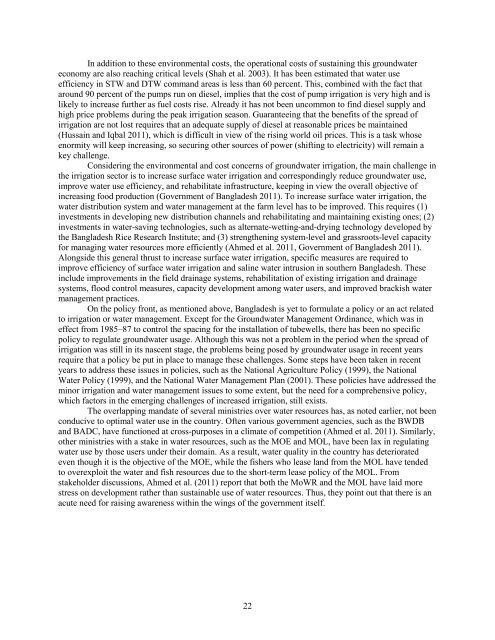Review of Input and Output Policies for Cereal Production in ...
Review of Input and Output Policies for Cereal Production in ...
Review of Input and Output Policies for Cereal Production in ...
You also want an ePaper? Increase the reach of your titles
YUMPU automatically turns print PDFs into web optimized ePapers that Google loves.
In addition to these environmental costs, the operational costs <strong>of</strong> susta<strong>in</strong><strong>in</strong>g this groundwater<br />
economy are also reach<strong>in</strong>g critical levels (Shah et al. 2003). It has been estimated that water use<br />
efficiency <strong>in</strong> STW <strong>and</strong> DTW comm<strong>and</strong> areas is less than 60 percent. This, comb<strong>in</strong>ed with the fact that<br />
around 90 percent <strong>of</strong> the pumps run on diesel, implies that the cost <strong>of</strong> pump irrigation is very high <strong>and</strong> is<br />
likely to <strong>in</strong>crease further as fuel costs rise. Already it has not been uncommon to f<strong>in</strong>d diesel supply <strong>and</strong><br />
high price problems dur<strong>in</strong>g the peak irrigation season. Guarantee<strong>in</strong>g that the benefits <strong>of</strong> the spread <strong>of</strong><br />
irrigation are not lost requires that an adequate supply <strong>of</strong> diesel at reasonable prices be ma<strong>in</strong>ta<strong>in</strong>ed<br />
(Hussa<strong>in</strong> <strong>and</strong> Iqbal 2011), which is difficult <strong>in</strong> view <strong>of</strong> the ris<strong>in</strong>g world oil prices. This is a task whose<br />
enormity will keep <strong>in</strong>creas<strong>in</strong>g, so secur<strong>in</strong>g other sources <strong>of</strong> power (shift<strong>in</strong>g to electricity) will rema<strong>in</strong> a<br />
key challenge.<br />
Consider<strong>in</strong>g the environmental <strong>and</strong> cost concerns <strong>of</strong> groundwater irrigation, the ma<strong>in</strong> challenge <strong>in</strong><br />
the irrigation sector is to <strong>in</strong>crease surface water irrigation <strong>and</strong> correspond<strong>in</strong>gly reduce groundwater use,<br />
improve water use efficiency, <strong>and</strong> rehabilitate <strong>in</strong>frastructure, keep<strong>in</strong>g <strong>in</strong> view the overall objective <strong>of</strong><br />
<strong>in</strong>creas<strong>in</strong>g food production (Government <strong>of</strong> Bangladesh 2011). To <strong>in</strong>crease surface water irrigation, the<br />
water distribution system <strong>and</strong> water management at the farm level has to be improved. This requires (1)<br />
<strong>in</strong>vestments <strong>in</strong> develop<strong>in</strong>g new distribution channels <strong>and</strong> rehabilitat<strong>in</strong>g <strong>and</strong> ma<strong>in</strong>ta<strong>in</strong><strong>in</strong>g exist<strong>in</strong>g ones; (2)<br />
<strong>in</strong>vestments <strong>in</strong> water-sav<strong>in</strong>g technologies, such as alternate-wett<strong>in</strong>g-<strong>and</strong>-dry<strong>in</strong>g technology developed by<br />
the Bangladesh Rice Research Institute; <strong>and</strong> (3) strengthen<strong>in</strong>g system-level <strong>and</strong> grassroots-level capacity<br />
<strong>for</strong> manag<strong>in</strong>g water resources more efficiently (Ahmed et al. 2011, Government <strong>of</strong> Bangladesh 2011).<br />
Alongside this general thrust to <strong>in</strong>crease surface water irrigation, specific measures are required to<br />
improve efficiency <strong>of</strong> surface water irrigation <strong>and</strong> sal<strong>in</strong>e water <strong>in</strong>trusion <strong>in</strong> southern Bangladesh. These<br />
<strong>in</strong>clude improvements <strong>in</strong> the field dra<strong>in</strong>age systems, rehabilitation <strong>of</strong> exist<strong>in</strong>g irrigation <strong>and</strong> dra<strong>in</strong>age<br />
systems, flood control measures, capacity development among water users, <strong>and</strong> improved brackish water<br />
management practices.<br />
On the policy front, as mentioned above, Bangladesh is yet to <strong>for</strong>mulate a policy or an act related<br />
to irrigation or water management. Except <strong>for</strong> the Groundwater Management Ord<strong>in</strong>ance, which was <strong>in</strong><br />
effect from 1985–87 to control the spac<strong>in</strong>g <strong>for</strong> the <strong>in</strong>stallation <strong>of</strong> tubewells, there has been no specific<br />
policy to regulate groundwater usage. Although this was not a problem <strong>in</strong> the period when the spread <strong>of</strong><br />
irrigation was still <strong>in</strong> its nascent stage, the problems be<strong>in</strong>g posed by groundwater usage <strong>in</strong> recent years<br />
require that a policy be put <strong>in</strong> place to manage these challenges. Some steps have been taken <strong>in</strong> recent<br />
years to address these issues <strong>in</strong> policies, such as the National Agriculture Policy (1999), the National<br />
Water Policy (1999), <strong>and</strong> the National Water Management Plan (2001). These policies have addressed the<br />
m<strong>in</strong>or irrigation <strong>and</strong> water management issues to some extent, but the need <strong>for</strong> a comprehensive policy,<br />
which factors <strong>in</strong> the emerg<strong>in</strong>g challenges <strong>of</strong> <strong>in</strong>creased irrigation, still exists.<br />
The overlapp<strong>in</strong>g m<strong>and</strong>ate <strong>of</strong> several m<strong>in</strong>istries over water resources has, as noted earlier, not been<br />
conducive to optimal water use <strong>in</strong> the country. Often various government agencies, such as the BWDB<br />
<strong>and</strong> BADC, have functioned at cross-purposes <strong>in</strong> a climate <strong>of</strong> competition (Ahmed et al. 2011). Similarly,<br />
other m<strong>in</strong>istries with a stake <strong>in</strong> water resources, such as the MOE <strong>and</strong> MOL, have been lax <strong>in</strong> regulat<strong>in</strong>g<br />
water use by those users under their doma<strong>in</strong>. As a result, water quality <strong>in</strong> the country has deteriorated<br />
even though it is the objective <strong>of</strong> the MOE, while the fishers who lease l<strong>and</strong> from the MOL have tended<br />
to overexploit the water <strong>and</strong> fish resources due to the short-term lease policy <strong>of</strong> the MOL. From<br />
stakeholder discussions, Ahmed et al. (2011) report that both the MoWR <strong>and</strong> the MOL have laid more<br />
stress on development rather than susta<strong>in</strong>able use <strong>of</strong> water resources. Thus, they po<strong>in</strong>t out that there is an<br />
acute need <strong>for</strong> rais<strong>in</strong>g awareness with<strong>in</strong> the w<strong>in</strong>gs <strong>of</strong> the government itself.<br />
22
















